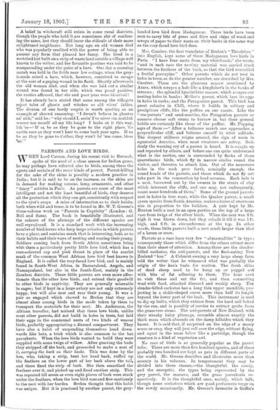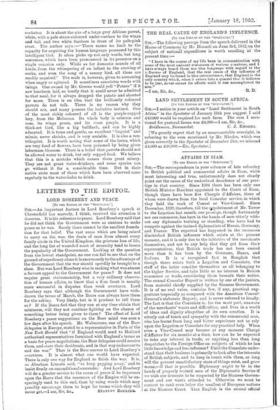PARROTS AND LOVE BIRDS.
WHEN Lord Curzon, during his recent visit to Burmab, spoke of the need of a close season for Indian game, he may perhaps have referred also to birds, among them the egrets and certain of the rarer kinds of parrot. Parrot-killing for the sake of the skins is possibly a modem practice in India; but it is said to be on the increase, as the skins are in demand for making screens, lamp ornaments, and other " fancy " articles in Paris. As parrots are some of the most intelligent and not the least beautiful of birds, they deserve all the protection which they can get, consistently with respect to the ryot's crops. A mine of information as to their habits, both when wild and tame, is to be found in Mr. W. T. Greene's three-volume work on "Parrots in Captivity" (London: G. Bell and Sons). The book is beautifully illustrated, and the colours of the plumage of the different species are well reproduced. It is a standard work with the increasing number of bird-lovers who keep large aviaries in which parrots have a place, and contains much that is interesting, both as to their habits and their ways of nesting and rearing their young. Soldiers coming back from South Africa sometimes bring with them a particularly pretty little love bird, which has a rose-coloured cap and pink throat in place of the scarlet mask of the common West African love bird best known in England. It is called the rosy-faced love bird, and. is mainly found in South-West Africa, in Damaraland, Angola, and Namaqualand, but also in the South-East, mainly in the Zambesi districts. These little parrots are even more affec- tionate than the other love birds, and extend their goodwill to other birds in captivity. They are generally miserable in cages; but if kept in a large aviary are not only extremely happy, but will also nest and rear their young. It was a pair so engaged which showed to Brehm that they are almost alone among birds in the mode taken by them to transport the materials for their nest. Mr. Andersson, the African traveller, had noticed that these love birds, unlike most other parrots, did not build in holes in trees, but laid their eggs in the communal nests of two kinds of weaver birds, probably appropriating a disused compartment. They have also a habit of suspending themselves head down- wards like bats, a trick which is also common to the bat parrakeets. When the love birds wanted to build they were supplied with some twigs of willow. After gnawing the buds they stripped off the bark, and proceeded to make a nest of it, carrying the bark on their backs. This was done by the hen, who, taking a strip, bent her head back, ruffled up the feathers on the lower part of her back above the tail, and there fixed the strip of bark. She then smoothed the feathers over it, and picked up and fixed another strip. This was repeated till seven or even eight pieces of bark were stuck under the feathers, when the love bird rose and flew cautiously to the nest with her burden Brehm thought that this habit was unique. But it is practised by another parrot, the grey-
headed love bird from Madagascar. These birds have been seen to carry bits of grass and fibre and chips of wood and scraps of paper to their nests on their backs in the same way as the rosy-faced love bird does.
Mrs. Cassirer, the first translator of Brehm's " Thierleben " into English, kept some of these Madagascan love birds in Paris. "I have four nests front my whiteheads," she wrote, "and in each case the nesting material was carried stuck between the feathers of the back, so that the bird resembled a fretful porcupine." Other parrots which do not nest in holes in trees, as do the greater number, are described by Mrs. Cassirer. These are the glaucous macaw mentioned by Azara, which scrapes a hole like a kingfisher's in the banks of streams ; the splendid hyacinthine macaw, which scrapes out nesting holes in banks ; Milller's parrot, which lays its eggs in holes in rocks; and the Patagonian parrot. This bird has great colonies in Chili, where it builds in solitary and precipitous cliffs, like the puffins on our coasts. Like the " sea-parrots " and sand-martins, the Patagonian parrots or conures choose soft strata to burrow in, but their general habits are curiously like those of the puffins. Mr. Popping says of them :—" After a toilsome march one approaches a perpendicular cliff, and believes oneself in utter solitude: The deepest stillness reigns around, the sign of noon in equatorial America, when most creatures arc asleep. Sud- denly the warning cry of a parrot is heard. It is caught up and repeated by others, and. before one can quite understand what is the matter, one is surrounded by flocks of these quarrelsome birds, which fly in narrow circles round the visitor, and threaten to attack him. Out of the numerous holes in the rock peer forth, comically enough, the round heads of the -parrots, and those which do not fly out take part in the commotion by loud screams. Each hole is a nest, burrowed out by the owners in the strata of clay which intersect the cliffs, and one may, not unfrequently, count some hundreds of them." Some of the ground parrots nest in holes in tree roots, while the Quaker parrot, a small- green species from South America, makes a house of enormous size in proportion to the builders. A pair kept by Mr. Buxton built a nest in an open portico on the top of a large vase from twigs of the silver birch. When the nest was 3 ft. high it was blown down, but they rebuilt it till it was & ft. high, and 6 ft. in circumference at the top. In other words, these little parrots built a nest much larger than that of a heron or crow.
Parrots as a race have very few "abnormalities" in type ; consequently those which differ from the others attract more than their share of attention. Among these are the slender- billed cockatoo, the owl-parrots, and the flesh-eating New Zealand " kea." A Colonist owning a very large sheep farm told the writer that he witnessed what was probably the origin of the kea's taste for mutton. The fresh skins of dead sheep used to be hung up or pegged out with bits of fat adhering to them. The keits used to visit these and. eat the fat, and then connecting wool with food, attacked diseased and weakly sheep. The slender-billed cockatoo has a long thin upper mandible, pro- jecting in a sickle-shaped curve more than half its length beyond the lower part of the beak. This instrument is used to dig up bulbs, which they extract from the bard soil baked by the sun, and is possibly of service to extract grubs from the grass-tree stems. The owl-parrots of New Zealand, with their streaky hairy plumage, resemble almost exactly the thick moss which abounds on the damp hillsides which they haunt. It is said that, if surprised on the edge of a mossy scaur or crag, they will just roll over the edge, without flying, and squat in the moss below like a partridge, though• the creature is a kind. of vegetarian owl.
No race of birds is so generally popular as the parrot tribe. There are more than flee hundred species, and of these probably two hundred are kept as pets in different parts of the world. Mr. Greene describes and illustrates more than seventy in his volumes. In temperament they may be divided into three classes,—the thoughtful, the rowdy, and the energetic, the types being represented by the grey parrot, the macaws, and the grass parrakeets re- spectively. It is the thoughtful ones, mainly, which talk, though some cockatoos which are good performers verge on the rowdy occasionally. Mr. Greene's favourite is Goffin's cockatoo. It is about the size of a large grey African parrot, white, with a pale straw-coloured under-surface to the wings and tail, and two white feathers in front of its pale-pink crest. The author says :—" There seems no limit to the capacity for acquiring the human language possessed by this intelligent bird. It often picks up not only words, but long sentences, which have been pronounced in its presence on a single occasion only. While as for domestic sounds of all kinds, from the whimpering of an infant to the crowing of cocks, and even the song of a canary bird, all these are readily acquired." The male is, however, given to screaming when angry or agitated. It sometimes associates words with things. One owned by Mr. Greene would yell "Potato" if it saw luncheon laid, so loudly that it could never be admitted to that meal, for it always dropped the potato and shouted for more. There is an idea that the brilliantly coloured parrots do not talk. There is no reason why they should not, and many possess the imitative instinct. One of the most richly coloured of all is the purple-capped lory, from the Moluccas. Its whole body is crimson and rose, its wings green, and its crest purple. It is a thick-set bird, like a big bullfinch, and can be highly educated. It is tame and gentle, an excellent " linguist " and mimic, never shrieks, and is very amiable. It is also a ven- triloquist. It is worth noting that some of the lories, which are very fond of flowers, have been poisoned by being given laburnum blossom. There is a belief that parrots should not be allowed water to drink, but only sopped food. We believe that this is a mistake which causes them great misery. They are not great water-drinkers, and some species can go without it for a considerable time. But in their native state most of those which have been observed come regularly to the water-holes to drink.







































 Previous page
Previous page